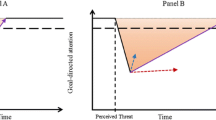Abstract
We demonstrate the use of a multidimensional extension of the latent Markov model to analyse data from studies with repeated binary responses in developmental psychology. In particular, we consider an experiment based on a battery of tests which was administered to pre-school children, at three time periods, in order to measure their inhibitory control (IC) and attentional flexibility (AF) abilities. Our model represents these abilities by two latent traits which are associated to each state of a latent Markov chain. The conditional distribution of the test outcomes given the latent process depends on these abilities through a multidimensional one-parameter or two-parameter logistic parameterisation. We outline an EM algorithm for likelihood inference on the model parameters; we also focus on likelihood ratio testing of hypotheses on the dimensionality of the model and on the transition matrices of the latent process. Through the approach based on the proposed model, we find evidence that supports that IC and AF can be conceptualised as distinct constructs. Furthermore, we outline developmental aspects of participants’ performance on these abilities based on inspection of the estimated transition matrices.
Similar content being viewed by others
References
Bartolucci, F. (2006). Likelihood inference for a class of latent Markov models under linear hypotheses on the transition probabilities. Journal of the Royal Statistical Society, Series B, 68, 155–178.
Bartolucci, F. (2007). A class of multidimensional IRT models for testing unidimensionality and clustering items. Psychometrika, 72, 141–157.
Bartolucci, F., Pennoni, F., & Francis, B. (2007). A latent Markov model for detecting patterns of criminal activity. Journal of the Royal Statistical Society, Series A, 170, 115–132.
Bartolucci, F., Pennoni, F., & Lupparelli, M. (2008). Likelihood inference for the latent Markov Rasch model. In C. Huber, N. Limnios, M. Mesbah, & M. Nikulin (Eds.), Mathematical methods for survival analysis, reliability and quality of life (pp. 239–254). London: Wiley.
Baum, L.E., Petrie, T., Soules, G., & Weiss, N. (1970). A maximization technique occurring in the statistical analysis of probabilistic functions of Markov chains. Annals of Mathematical Statistics, 41, 164–171.
Berchtold, A. (2004). Optimization of mixture models: Comparison of different strategies. Computational statistics, 19, 385–406.
Birnbaum, A. (1968). Some latent trait models and their use in inferring an examinee’s ability. In F.M. Lord & M.R. Novick (Eds.), Statistical theories of mental test scores (pp. 395–479). Reading: Addison-Wesley.
Boucheron, S., & Gassiat, E. (2007). An information-theoretic perspective on order estimation. In O. Cappé, E. Moulines, & T. Rydén (Eds.), Inference in hidden Markov models (pp. 565–602). New York: Springer.
Christensen, K.B., Bjorner, J.B., Kreiner, S., & Petersen, J.H. (2002). Testing unidimensionality in polytomous Rasch models. Psychometrika, 67(4), 563–574.
Connell, A., & Frye, A. (2006). Growth mixture modelling in developmental psychology: Overview and demonstration of heterogeneity in developmental trajectories of adolescent antisocial behaviour. Infant and Child Development, 15, 609–621.
Dempster, A.P., Laird, N.M., & Rubin, D.B. (1977). Maximum likelihood from incomplete data via the EM algorithm (with discussion). Journal of the Royal Statistical Society, Series B, 39, 1–38.
Donohoe, G., Reilly, R., Clarke, S., Meredith, S., Green, B., Morris, D., Gill, M., Corvin, A., Garavan, H., & Robertson, I.H. (2006). Do antisaccade deficits in schizophrenia provide evidence of a specific inhibitory function? Journal of the International Neuropsychological Society, 12, 901–906.
Frye, D., Zelazo, P.D., & Burack, J.A. (1998). Cognitive complexity and control: I. Implications for theory of mind in typical and atypical development. Current Directions in Psychological Science, 7, 116–121.
Gerstadt, C.L., Hong, Y.J., & Diamond, A. (1994). The relationship between cognition and action: Performance of children 3.5-7 years old on a stroop-like day-night test. Cognition, 53, 129–153.
Glas, C.A.W., & Verhelst, N.D. (1995). Testing the Rasch model. In G.H. Fischer & I.W. Molenaar (Eds.), Rasch models: Foundations, recent developments, and applications (pp. 69–95). New York: Springer.
Happaney, K., & Zelazo, D. (2003). Commentaries: Inhibition as a problem in the psychology of behavior. Developmental Science, 6, 468–470.
Juang, B., & Rabiner, L. (1991). Hidden Markov models for speech recognition. Technometrics, 33, 251–272.
Kamata, A. (2001). Item analysis by hierarchical generalized linear models. Journal of Educational Measurement, 38, 79–93.
Keribin, C. (2000). Consistent estimation of the order of mixture models. Sankhyā, Series A, 62, 49–66.
Kimberg, D.Y., & Farah, M.J. (2000). Is there an inhibitory module in the frontal cortex? Working memory and the mechanisms underlying cognitive control. In S. Monsell & J. Driver (Eds.), Attention and performance XVIII: Control of cognitive processes (pp. 740–751). Cambridge: MIT Press.
Kirkham, N.Z., Cruess, L., & Diamond, A. (2003). Helping children apply their knowledge to their behavior on a dimension-switching task. Developmental Science, 6, 449–476.
Langeheine, R., & van de Pol, F. (2002). Latent Markov chains. In J.A. Hagenaars & A.L. McCutcheon (Eds.), Advances in latent class analysis (pp. 304–341). Cambridge: Cambridge University Press.
Lazarsfeld, P.F., & Henry, N.W. (1968). Latent structure analysis. Boston: Houghton Mifflin.
MacDonald, I.L., & Zucchini, W. (1997). Hidden Markov and other models for discrete-valued time series. London: Chapman and Hall.
Martin-Löf, P. (1973). Statistiska modeller. Stockholm: Institütet för Försäkringsmatemetik och Matematisk Statistisk vid Stockholms Universitet.
McLachlan, G.J., & Peel, D. (2000). Finite mixture models. New York: Wiley.
Muthén, B.O. (1983). Latent variable structural equation modelling with categorical data. Journal of Econometrics, 22, 43–65.
Muthén, B.O. (2001). Second-generation structural equation modeling with a combination of categorical and continuous latent variables: New opportunities for latent class/latent growth modeling. In L. Collins & A. Sayer (Eds.), New methods for the analysis of change (pp. 291–322). Washington: American Psychological Association.
Muthén, B.O., & Shedden, K. (1999). Finite mixture modeling with mixture outcomes using the EM algorithm. Biometrics, 55, 463–469.
Nagin, D. (1999). Analyzing developmental trajectories: A semi-parametric, group-based approach. Psychological Methods, 4, 139–157.
Nagin, D., & Tremblay, R. (2001). Analyzing developmental trajectories of distinct but related behaviors: A group-based method. Psychological Methods, 6, 18–34.
Paas, L.J., Vermunt, J.K., & Bijmolt, T.H.A. (2007). Discrete-time, discrete-state latent Markov modelling for assessing and predicting household acquisitions of financial products. Journal of the Royal Statisical Society, Series A, 170, 955–974.
Rasch, G. (1961). On general laws and the meaning of measurement in psychology. In Proceedings of the IV Berkeley symposium on mathematical statistics and probability (Vol. 4, pp. 321–333).
Schneider, W., Schumann-Hengsteler, R., & Sodian, B. (Eds.) (2005). Young children’s cognitive development: Interrelationships among executive functioning, working memory, verbal ability, and theory of mind. Mahwah: Lawrence Erlbaum Associates.
Schwarz, G. (1978). Estimating the dimension of a model. Annals of Statistics, 6, 461–464.
Self, S.G., & Liang, K.-Y. (1987). Asymptotic properties of maximum likelihood estimators and likelihood ratio tests under nonstandard conditions. Journal of the American Statistical Association, 82, 605–610.
Shapiro, A. (1988). Towards a unified theory of inequality constrained testing in multivariate analysis. International Statistical Review, 56, 49–62.
Shimmon, K.L. (2004). The development of executive control in young children and its relationship with mental-state understanding: A longitudinal study. Ph.D. thesis, Lancaster University, UK.
Silvapulle, M.J., & Sen, P.K. (2004). Constrained statistical inference: Inequality, order, and shape restrictions. New York: Wiley.
Takane, Y., & de Leeuw, J. (1987). On the relationships between item response theory and factor analysis of discretized variables. Psychometrika, 52, 393–408.
Towse, J.N., Redbond, J., Houston-Price, C.M.T., & Cook, S. (2000). Understanding the dimensional change card sort perspectives from task success and failure. Cognitive Development, 15, 347–365.
van den Wollenberg, A.L. (1982a). A simple and effective method to test the dimensionality axiom of the Rasch model. Applied Psychological Measurement, 6, 83–91.
van den Wollenberg, A.L. (1982b). Two new test statistics for the Rasch model. Psychometrika, 47, 123–140.
Verhelst, N.D. (2001). Testing the unidimensionality assumption of the Rasch model. Methods of Psychological Research Online, 6, 231–271.
Vermunt, J.K., Langeheine, R., & Böckenholt, U. (1999). Discrete-time discrete-state latent Markov models with time-constant and time-varying covariates. Journal of Educational and Behavioral Statistics, 24, 179–207.
Vermunt, J.K., & Magidson, J. (2007). LGSyntax users guide: Manual for Latent Gold 4.5 and Latent Gold Choice 4.5 Syntax Module. Belmont: Statistical Innovations.
Viterbi, A. (1967). Error bounds for convolutional codes and an asymptotically optimum decoding algorithm. IEEE Transactions on Information Theory, 13, 260–269.
Wiggins, L.M. (1973). Panel analysis: Latent probability models for attitude and behavior processes. Amsterdam: Elsevier.
Zelazo, P.D., & Frye, D. (1998). Cognitive complexity and control: II. The development of executive function in childhood. Current Directions in Psychological Science, 7, 121–126.
Zelazo, P.D., Frye, D., & Rapus, T. (1996). An age-related dissociation between knowing rules and using them. Cognitive Development, 11, 37–63.
Author information
Authors and Affiliations
Corresponding author
Rights and permissions
About this article
Cite this article
Bartolucci, F., Solis-Trapala, I.L. Multidimensional Latent Markov Models in a Developmental Study of Inhibitory Control and Attentional Flexibility in Early Childhood. Psychometrika 75, 725–743 (2010). https://doi.org/10.1007/s11336-010-9177-1
Received:
Revised:
Published:
Issue Date:
DOI: https://doi.org/10.1007/s11336-010-9177-1




